BML - Edition 24
Fractal thinking for branding
Subpart 2 - How to Fracture Your Brand Identity
Everyone has a reputation. In the same way, every business has a brand.
If you're a solopreneur, you might not think of yourself as having a brand. You might call it world-building or your tribe or the thing your true fans unite beneath.
No matter what you call it, rest assured, you have a brand.
The question is this: Have you put intention into this brand?
Don't worry, I haven't done a great job of this. A big problem is most of the advice you read on branding is very superficial.
I'm hoping this teaching below will give you more substance.
It all started once I began studying storytelling, fractals, and symbolism, and learned the inner workings of identity.
Finally, it clicked. And I saw that if we understand how identity works, we understand how branding works.
My biggest "aha" around branding has been this: Identity is fractal.
So, let's keep going with this series on Fractal Thinking.
We're in a mini-series within the larger series (see the fractal pattern?) and are applying Fractal Thinking to branding.
Last week, I introduced you to our fractal approach to branding. Next week, I'll give you some practical exercises.
Today, let's explore how a brand can fracture.
To explain how a brand identity can fracture, symbolism expert Jonathan Pageau encourages us to think about being a member of a club.
Let's use my old homebrewing club.
Our homebrewing club got together once a month to talk hop varieties, brewing chemistry, and of course, we'd taste each others creations.
Now, imagine this . . .
At the end of a meeting, a homebrew club member stands up and asks, "Anyone up for a game of poker?"
"I love poker!" shouts another member.
"Count me in" exclaims another guy.
Next thing you know, there's a poker game.
And that's okay, because the main meeting was about homebrewing. Poker came afterwards.
But what if at the next meeting, we again ended with poker? And what if poker eventually became as popular as homewbrewing?
What might happen to the club?
The identity of the club would fracture. Some people will leave. New members will join. And we'd be forced to ask . . .
"What type of club is this? A homebrewing club or a poker club?"
We may even rename our group to "San Diego Homebrewing & Poker Club".
The club becomes a hybrid, and hybrid brands rarely last. Almost always, one of the identities will dominate. And this usually happens by accident because of the leader's confusion around the brand's intended identity.
This happens with every business, from the big corporation down to the solopreneur.
If you don't set a clear intention for your brand identity, and establish clear rules about what's allowed and not allowed, the identity will transform, fracture, or entirely dissolve.
Here's a visual of how this homebrewing club's brand identity might fracture.
(Yes, I'm having way too much fun with ChatGPT and yes, I made all these dudes look like me. Aren't they handsome?)
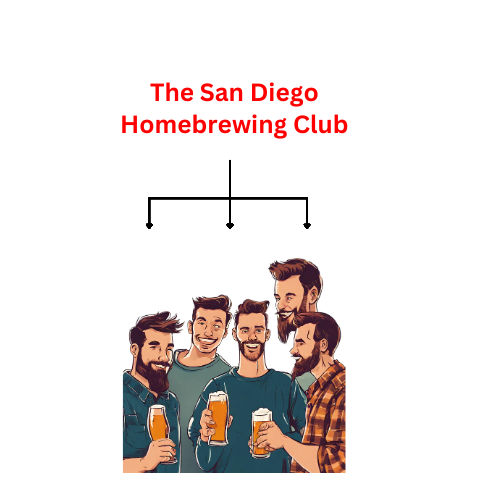
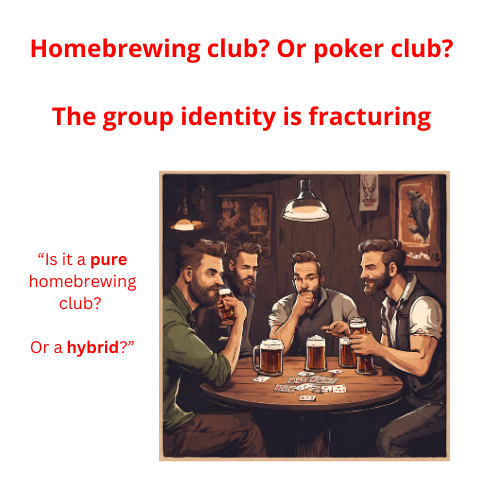
You can see the brand is also a judge. It's a judge because it judges what is allowed and not allowed.
"Is poker allowed in our club? Or not allowed?"
Without rules, your identity is at risk. Ans when an identity is in constant flux, it's difficult to maintain. It's the reason I lost my love for following major league baseball.
In baseball, the players used to stick with a team their entire careers. I was a huge Cal Ripken fan, and he would never leave the Orioles.
Today, the players change teams every couple years. That's why I still love the game of baseball, but have lost most interest in following a professional team.
How do you maintain an identity when the embodiment of that identity is constantly changing? It's difficult.
Just as a new player arrived on The Orioles and spent a couple seasons becoming acclimated to "The Oriole Way," whoosh! That player would vanish.
You see this happening in all professional sports. Hopefully, now, you see it through a different lens and understand the inner workings.
Let me tell you another story, this one about Gap . . .
Check out this evolution of the Gap logo:
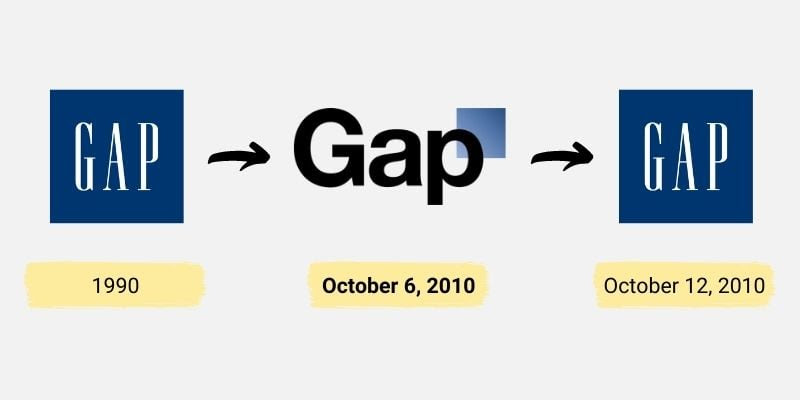
Yep, they changed they logo back within a week. What happened?
The morning of October 6th, 2010, Gap unveiled its new logo. It got a massive backlash. Social media was pissed at Gap.
You've got to be careful when messing with identity. People develop trust with your brand and if that identity fractures or changes, it can break that trust. And you just saw an example of how people can respond.
So, take these teachings on identity seriously.
Now, let me elaborate on a couple of the rules I gave you last week, and in doing so you'll see how a brand can fracture. That way, you can avoid it for yourself.
Rule: An identity must be embodied.
Just like a living organism, a brand needs various components (employees, customers, products, values, and rituals) to embody and express its identity.
Without this embodiment, the brand can fade or become irrelevant. Let's look at what happens when a brand identity is not embodied.
We'll keep going with our baseball theme and use a team that no longer exists: The Washington Senators.
Defunct in 1960, it's been more than 50 years since The Senators have played a game. You can think of the Senators as a disembodied entity.
Here's a visual:
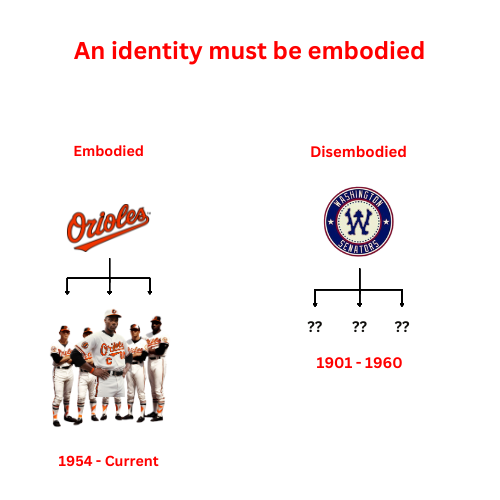
The Washington Senators are kinda like a ghost, floating around but not really fully existing.
Now, is the identity of the Washington Senators totally dead? No.
We still talk about the Senators. Older fans have memories and there are historical records.
Oh, forgotten brands do exist, but we don't talk about them. If we did, they wouldn't be forgotten. Duh.
The moment we speak about something, we make it real. It's kinda like that Heraclitus quote:
No man ever steps into the same river twice; for it's not the same river and he's not the same man.
It's also similar to the idea that the moment a secret vacation spot becomes popular, it becomes ruined. The act of observing it forever changes it.
And now that I'm writing this, I'm reminded of my Mexican in-laws and their beautiful tradition around Día de Muertos, a holiday with an emphasis on remembering your loved ones who have passed.
As long as you remember your loved ones, they'll always exist.
These examples all teach us the same thing . . .
These identities aren't real in the material sense, but they're very much real. They're simply embodied in different ways.
And when you're communicating with people, as you do through your marketing material, you cannot afford to be blind to these inner workings of identity.
Even if you don't think this concept is "real" (whatever you mean by that), we humans act as if it's real, and for our purposes of finding fruitful communication, that's all that matters.
Now, let's look at the second rule, which is the flip side of the first.
Rule: You must have a unifier.
In your business, the parts, people, and processes must be unified. Something above must align everything. That something animates your business and gives it purpose.
If you lack this unifier, your business will suffer from:
Inconsistency in messaging
Random acts of marketing
Employees who don't complement each other and sow discord
Lack of purpose and direction
And on.
If you've seen the classic 90's movie The Little Giants, you've seen the transformation from random to cohesive.
In the movie, a ragtag group of kids show up in a disjointed image. This diversity in their appearance symbolizes their unique identities (which is equally important, btw) but they lack a unified team identity.
Over the movie, they transform into a cohesive identity -- a team.
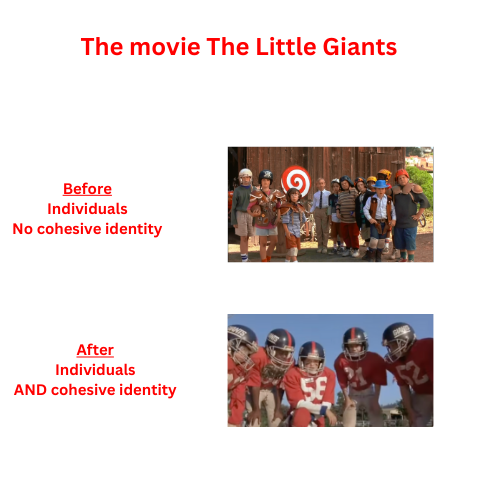
To wrap up this edition, I want you to think about the following:
1) Knowing that every business has a brand, have I taken the time to think about my brand identity?
2) After reading this teaching, in what ways might I be fracturing my brand? Have I set clear rules for what's allowed?
3) How is my brand being embodied? Is my brand like a disembodied spirit? Or the opposite, random and not cohesive?
Next week, we'll move from the theory more into the practical. I'll give you direction on how you can begin to incorporate these concepts into the day-to-day of your business.
Rooting for you,
Billy
